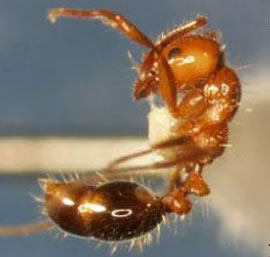Fire Ants
If you didn't already know, fire ants are ferocious little insects with a painful sting that feels like a tiny pinpoint of fire is burning through your skin if you're unlucky enough to fall victim to one!
They are to be avoided when at all possible and never tangled with if you happen upon any.
 If you wanted to know more about these aggressive, stinging ants (Latin name: Solenopsis invicta) and their habits, here is some fascinating information all about the much unloved insects!
If you wanted to know more about these aggressive, stinging ants (Latin name: Solenopsis invicta) and their habits, here is some fascinating information all about the much unloved insects!
Description
Let's start off with a written description of what one of these fiery stinging little creatures looks like. They're quite small, being around 2-6mm in length although you'll find a variety of sizes inhabiting each nest. The head and body of this insect is a coppery-brown colour while the abdomen is darker.
Fire ants are highly aggressive insects, particularly when they're near their nest. If you allow one of these insects to climb onto you, it can inflict a painful sting similar to a hornet's which may need medical attention in sever cases.
Nests
As already mentioned, fire ant nests can contain a range of ant sizes, so there is no uniformity in their dimensions. One thing you'll notice when you happen upon one is that there are no obvious entry or exit holes.
The inhabitants usually place their homes near the base of the hill and often facing a camouflaging barrier like a tree or bush. The nests and hills themselves can be of various shapes and sizes, although they often appear as dome-shaped mounds, which can be up to 40 cm high.
Similar Species
These six legged little monsters can easily be and often are confused with the common brown ant as well as other local native ants. However, it is usually not a good idea to go up to one to find out for sure, unless you're qualified to handle them.
Location of Nests
The nest mounds are not always so obvious, but are often found in open areas such as lawns, open flower beds, arable fields, along roadsides and on unused cropland. These nests can also be found next to, or even beneath other objects that are found on the ground.
These can include stacked timber or logs, rocks, paving slabs, bricks or other building materials. Abandoned vehicles are also targeted as good cover for their underground dwellings.
Nests can also be found inside buildings and also near electrical equipment. Conversely, their nest mounds are rarely found in frequently cultivated areas.
Human Health
These insects can inflict a painful, hornet-like sting, which can cause a severe acute allergic reaction (anaphylaxis). If you are stung by a fire ant, you should apply first aid or neat vinegar to the skin as this will reduce the pain and help to negate the effects of the sting.
Seek medical attention if you are allergic to insect stings or you are in any doubt whatsoever. For more information you might like to visit these government resource sites: www.invasivespeciesinfo.gov and www.cdfa.ca.gov.